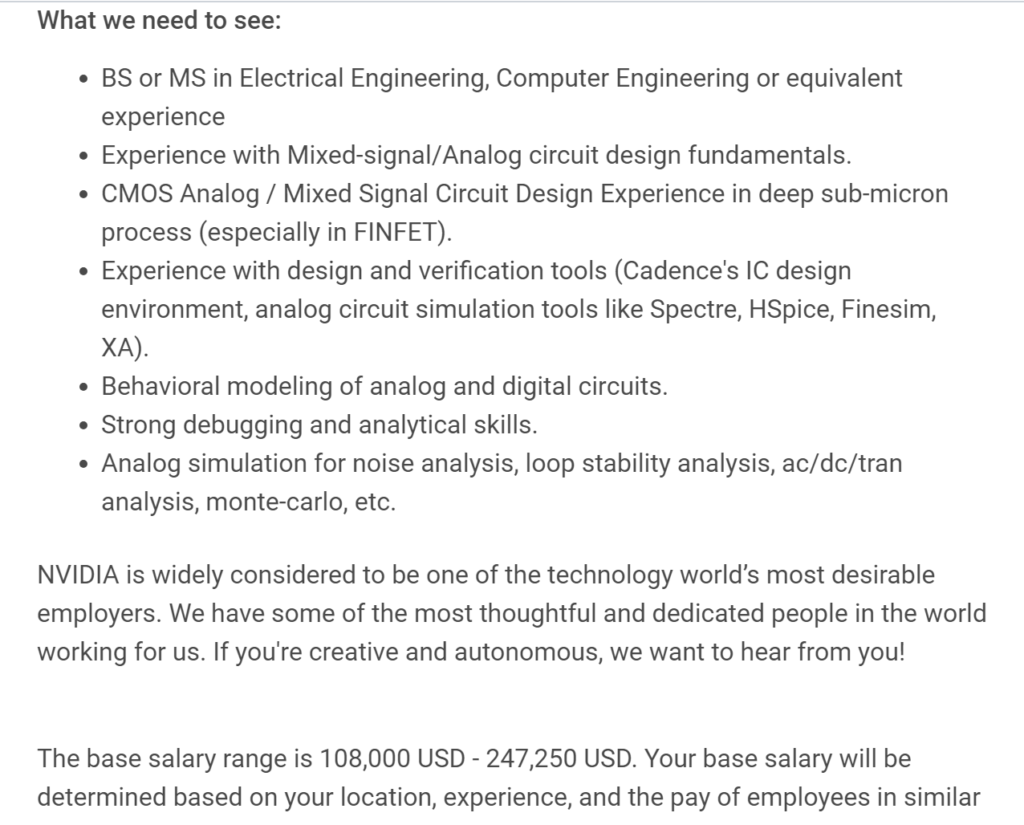How to Become an Electrical Engineer (2024)
To become an Electrical Engineer, you must earn a bachelor’s in Electrical/Electronics Engineering. This requires many advanced math, physics, and electrical engineering classes which take most people at least 4 years in college to complete. Although almost always required for Civil Engineers (but not Electrical Engineers), your employer may also value you more (i.e. give you a raise) by passing the Fundamentals of Engineering (FE) Electrical Engineering exam.
What jobs can you get as an Electrical Engineer?
You can get jobs such as a Mixed Signal Design Engineer, SOC Firmware Engineer, Power Electronics Test Engineer, Digital Signal Processing Engineer, and more:
Mixed-Signal Design Engineer – Nvidia


When thinking of Electrical Engineering, you probably imagine electronics like capacitors, resistors, and transistors. A Mixed Signal Design Engineer designs and validates digital and analog integrated circuits used as computer chips on Printed Circuit Boards (PCBs).
Radio Frequency Electrical Engineer – Lockheed Martin

This job deals with simulating and predicting aircraft electromagnetic signatures so you can accurately determine what kind of aircraft is flying above you. For most universities, an Electromagnetics class is required as an Electrical Engineering major.
Depending on the location, this job has a salary between $57,800 and $110,800.
SOC Firmware Engineer – Apple


Closer to the Computer Engineering and Computer Science realm, you work here as a System On a Chip (SOC) Firmware Engineer writing low-level C, Python, Perl, and Tcl firmware code to test and bring up new computer chips used in Apple’s consumer products. You also need knowledge of Digital Signal Processing, Computer Architecture, and Software Testing as well as wireless communication knowledge of Bluetooth, WLAN, and Zigbee.
The base pay is between $138,900 and $256,500 depending on experience, skills, qualifications, and location.
Power Electronics Test Engineer, Drive Inverter – Tesla



In this role, you’ll be using your knowledge of semiconductor power conversion integrated circuits (IC) to validate and test the power conversion loss factor when converting from one power level voltage/current to another power level for Tesla’s electronic inverter. Converting from one power level to another involves a loss of energy, which results in heating the inverter; you’ll need to verify that the temperature is at an appropriate level so it doesn’t damage other components inside and outside of the inverter module.
The yearly salary is between $80,000 and $300,000 + cash + stock awards + benefits, depending on experience, skills, and location.
Digital Signal Processing Engineer


As a Digital Signal Processor (DSP) Engineer, you’ll need to use the knowledge you gained in your Digital Signal Processing, Software Design, and Artificial Intelligence courses and experience to test and develop target tracking and weapons systems.
The salary for a similar position is between $75,200 and $130,900 annually, depending on knowledge, skills, and experience.
Photonics/Electro-Optics Engineer – General Dynamics


In this role, you’ll use your knowledge of solid-state electronic devices, electromagnetics, and integrated circuit design to design and test photonic systems that transmit data using light with and without fiber optic cables.
The pay is between $145,161 and $161,038 annually depending on location and experience.
Hardware Reverse Engineer




Every electrical engineering student takes an embedded C programming class; continued classes and experience lead you to understand how the physical layer of communication protocols between two electronic devices including Inter-Integrated Circuit (I2C), Serial Peripheral Interface (SPI), and Peripheral Component Interconnect Express (PCIe).
Another desired skill for this position is experience with a Side Channel Analysis/Attack and Fault Injection. An example of a hardware-based side channel attack is differential power analysis, in which you measure the power used by a microprocessor to figure out what its cryptographic keys are to try to decrypt the information it’s sending across a communication channel.
Secret, Top-Secret, and SCI’s exact job positions aren’t usually very descriptive because of the nature of their work. Considering this position needs a Top-Secret clearance, you’ll most likely be taking apart and trying to understand what foreign-made electronics do and how to gather as much information from them as possible using the above communication protocols and side-channel attacks.